Virtual Workplace: Top Companies Making It Work and How
Virtual Workplace: Top Companies Making It Work and How

Unless you're still living in 2019, you’ve probably heard all the buzz of remote work and the shift to the virtual workplace. If you need a refresher, the virtual workplace is a business that isn’t located in any physical space; rather, employees are technologically connected via the internet so they can work anywhere, even in different geographical locations.
Whether it’s from home, a coffee shop, or even a vacation beach house, employees that work in a virtual workplace can do business virtually, anywhere.
If your business is considering making a shift to the virtual workplace, keep reading to find out everything you need to know about running a remote business as well as companies that are excelling at it.
The rise of the virtual workplace
The rise of the virtual workplace began as new technologies such as PCs, cell phones, voicemail, and the internet became the norm. However, for business owners, managers, and staff, fully adopting the virtual workplace was still up for debate.
In 2019, only 6% of the employed worked primarily from home and many companies feared the potential associated drawbacks, such as drops in worker productivity and limited employee engagement.
Once the COVID-19 pandemic struck in 2020, it completely disrupted millions of organizations worldwide and forced many office workers to adopt a virtual workplace whether they were planning on it or not. Although the shift was abrupt, employees have shown resilience and perseverance, proving that they can be highly effective in virtual environments.
.avif)
By the end of 2021, about 18% of professional jobs were fully remote, and that’s expected to increase. A survey conducted by Upwork estimates that by the year 2025, 22% of Americans will be working remotely.
With advancing technology and employees proving that they can be just as productive (if not more) while working remotely, it’s fair to say the virtual workplace is here to stay.
What are the benefits of a virtual workplace?
While businesses feared drawbacks of a virtual workplace pre-pandemic, the unavoidable shift to a remote work model has proven to be beneficial in many ways.

Boosts productivity
For one, employees have proven that working remotely doesn’t negatively affect their productivity. An Owl Labs study found that 90% of employees are at the same — or higher — productivity level working from home compared to the office. Since employees have no commute, less or no colleague small talk, and fewer office distractions, their productivity is boosted despite being in a virtual and “casual” setting.
It turns out you don’t need the watchful eye of a manager over your shoulder, but remote work productivity apps do help business leaders manage staff output. Virtual Private Networks (VPN) also ensure privacy and security of work completed at home.
Reduces overhead costs
Another great benefit to adopting the virtual workplace is the reduction of overhead costs. Without the need for a physical office, it eliminates the need for you to pay rent and utilities or constantly move into larger offices as your business grows.
For instance, calculations from Global Workplace Analytics suggest that companies can save around $11,000 per employee per year if they allow their employees to work remotely just 50% of the time. Considering a virtual workplace is fully remote, this number could increase, allowing companies to experience a large financial benefit.
Preferred by employees
Now that most employees have gotten a taste of the remote lifestyle, many don’t want to give it up. In the Owl Labs study, 84% of employees shared that working remotely after the pandemic would make them happier, with many even willing to take a pay cut. Since employees have more time for family, hobbies, and exercise, they develop a better overall work-life balance, which is essential for employee satisfaction and long-term retention.
Better for the environment
The virtual workplace isn’t just good for the employers and the employees, but for the environment as well. Telecommuting reduces greenhouse gas emissions by an amount equivalent to 600,000 cars in the U.S. Since people have the option to work from home, commuting isn’t necessary, which means that fewer cars are used and pollution levels go down substantially.
Must-have solutions for a successful virtual workplace
Once upon a time, virtual workforces were considered difficult to engage, monitor, and manage. In the last few years, however, new technologies like video chat, project management tools, and outsourced support like 24/7 virtual receptionists now make managing a virtual workplace more practical and feasible.
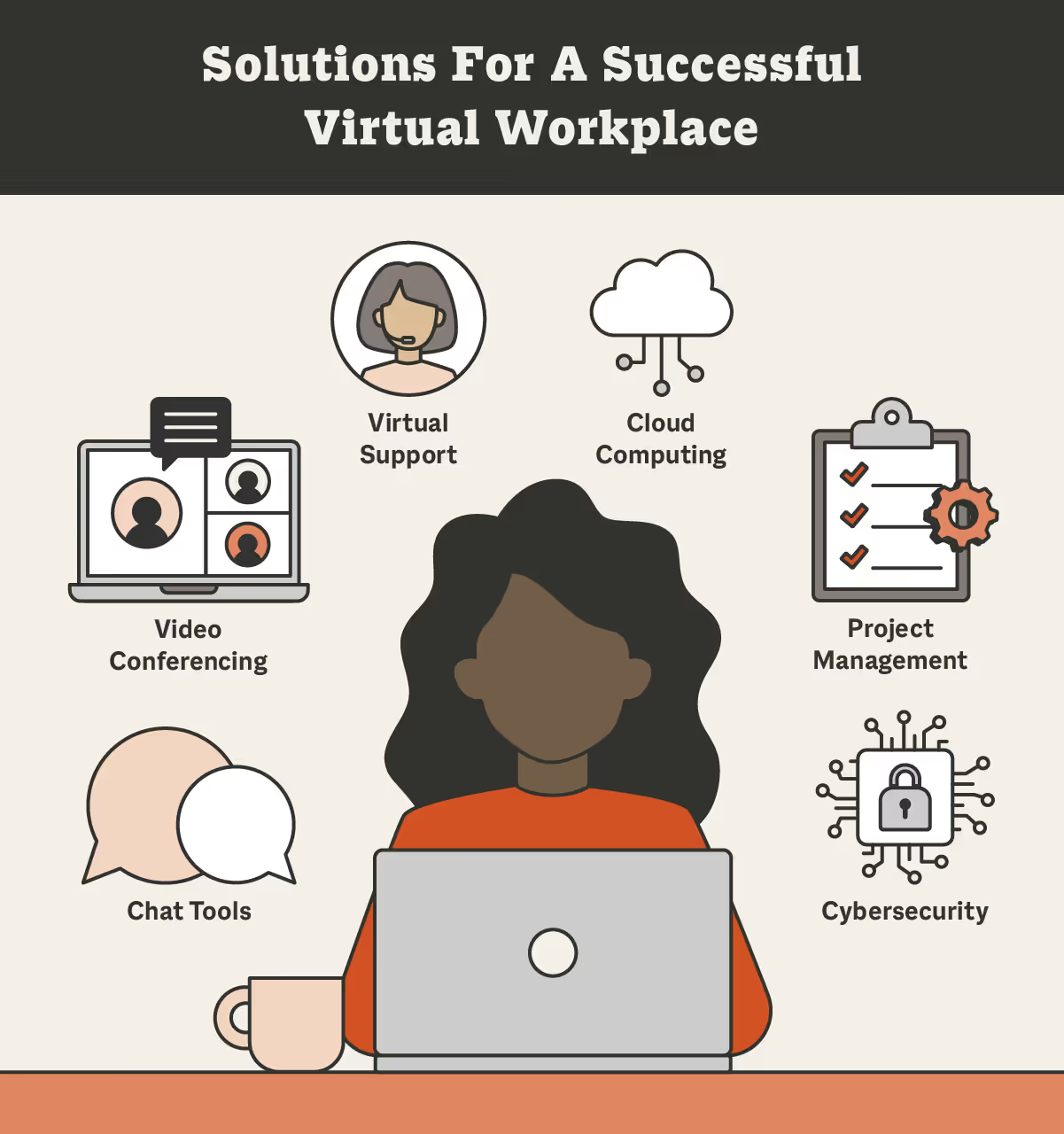
- Project management - These applications are a must in a virtual workplace as they help you and your team plan and manage projects, keep track of team tasks, and manage to-do lists across multiple platforms. Some examples include Basecamp, Microsoft Project, and Trello.
- Cloud computing - These tools allow you to store and share files securely with your entire team or authorized individuals via the cloud rather than using standard email or fax. Dropbox, Google Drive, and Microsoft Azure are some of the more widely used tools for these purposes.
- Chat tools - Since “watercooler” chat isn’t an option in a virtual workplace, a chat platform that allows employees to engage with each other is essential. Platforms such as Slack and Microsoft Teams allow for public or private messaging between team members, which supports real-time communication and collaboration.
- Video conferencing - Technology that allows you to meet with team members in a virtual setting are important to encourage collaboration and build a sense of togetherness. With a virtual conferencing platform like Zoom of GoTo Meeting, you can video chat with teammates and clients, share your screen, create recordings, and work through all matters of business.
- Security - Tools that help your business secure login information and prevent cyberattacks are essential in a virtual workplace, and security must be a top priority. Use tools such as Cisco Umbrella and 1Password to secure your network, protect company-owned devices, and manage passwords.
- Virtual support - Investing in virtual support extends the capacity and work-life balance of your remote team, helping you better manage staff and their productivity by reducing interruptions like incoming calls. Services like those Smith.ai provides, including 24/7 virtual receptionists, live-staffed chat, and outsourced sales development help you increase efficiency and avoid interruptions so you can focus on other important business matters.
Companies embracing the virtual workplace
If you are contemplating or in the process of making a shift toward a virtual workplace, take a look at these remote companies that are excelling at the remote work lifestyle.
Adobe
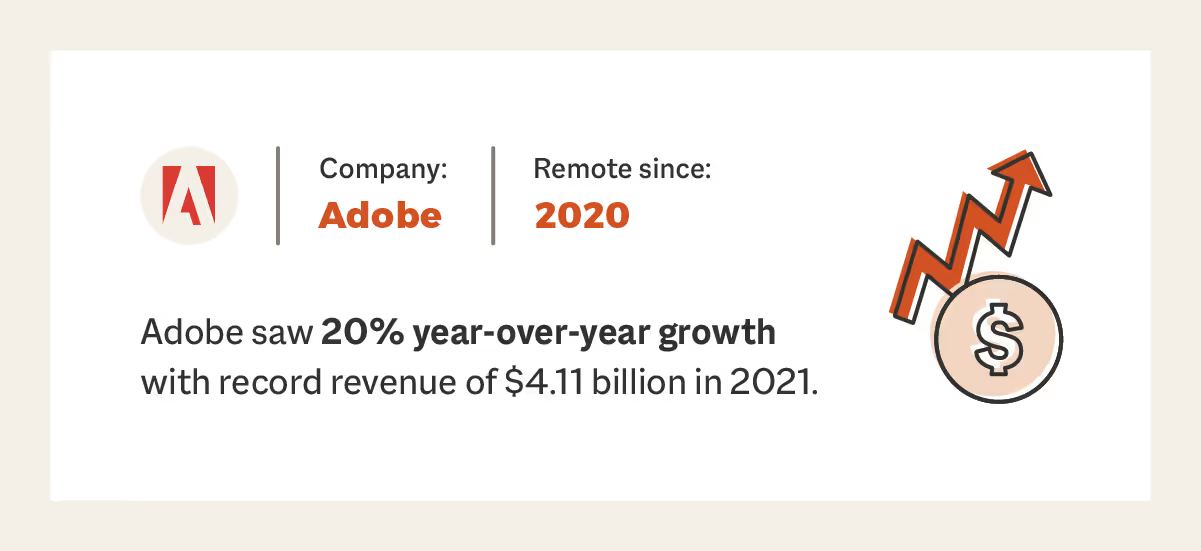
Who are they?
Adobe is a computer software company known for its multimedia and creativity products such as Photoshop and Adobe Creative Cloud. Although Adobe always valued in-person work, they adopted a virtual workplace once the pandemic struck and now plan to expand remote work and become a digital-first company.
Company’s success:
Not only was Adobe named the No. 1 company with the happiest employees in 2021, but they also had record performances. In Q4 of fiscal year 2021, Adobe saw 20% year-over-year growth with record revenue of $4.11 billion.
How they do it:
For Adobe to achieve such success, they prioritize their employees which has proven to help with overall efficiency, engagement, and productivity. During the start of the pandemic, they were one of the first companies to issue a “no lay-off pledge” which eased employee concerns and signaled the company’s commitment to its workforce.
While working from home was mandatory during the pandemic, Adobe regularly checked in on its workforce using surveys and took action when burnout was detected, like giving all employees an extra day off each month to unplug and recharge.
By prioritizing employee satisfaction Adobe was able to increase engagement scores and, in turn, improve overall performance.
FlexJobs
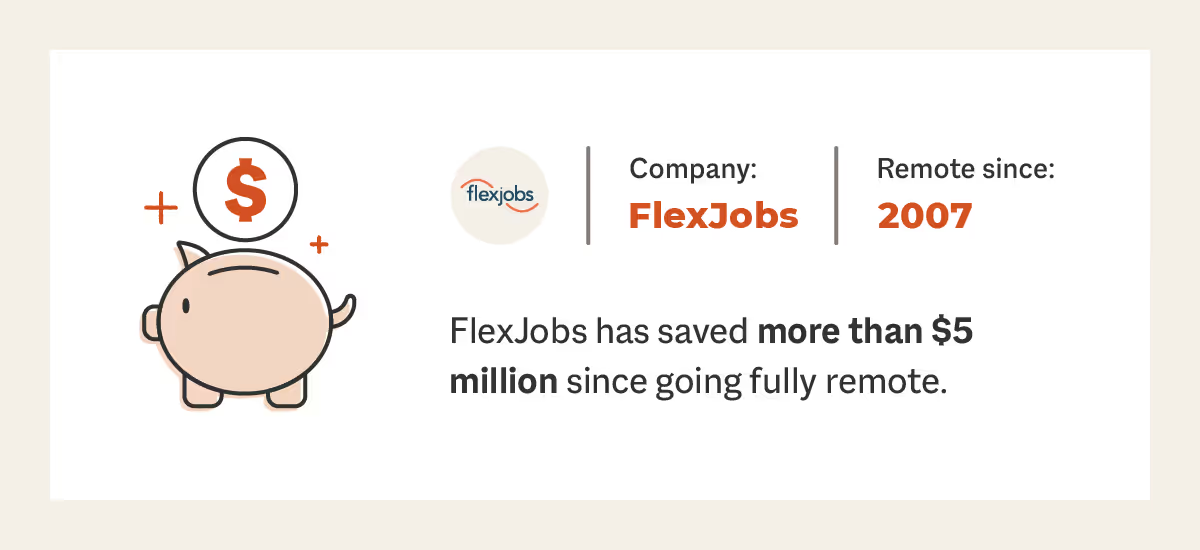
Who are they?
FlexJobs is a job search site that allows you to find flexible and remote jobs. It’s no surprise that a company that helps you find remote work has been working in the virtual workspace since 2007.
Company’s success:
Since becoming fully remote, FlexJobs has saved more than $5 million on things like overhead costs, real estate, transit subsidies, and continuity of operations. Not only that, but they’ve also seen many positive metrics such as a 15% increase in productivity and a 25% decrease in absenteeism.
How they do it:
FlexJobs sticks to their core values of improving the future of work by helping people find flexible jobs. This allows them to walk the walk and give their employees the autonomy they need to work in a way that suits them best.
GitLab
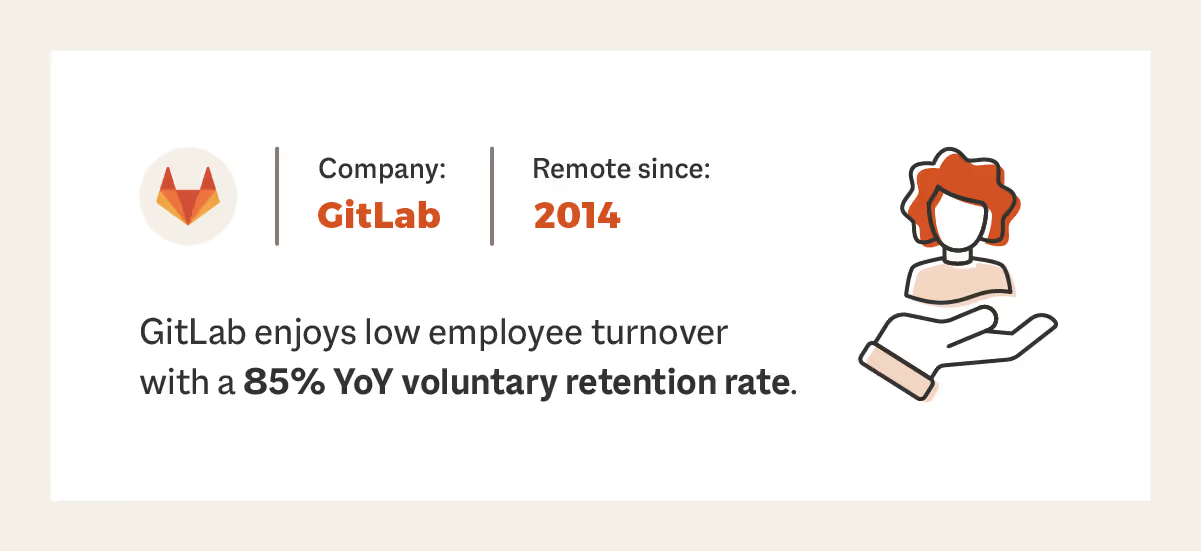
Who are they?
GitLab is a software company that combines the ability to develop, secure, and operate software in a single application. The company has been fully remote since its founding in 2014.
Company’s success:
While being a 100% remote company, GitLabs enjoys the various benefits of its virtual workforce, including a 85% year-over-year voluntary retention rate.
How they do it:
Since employees can work virtually anywhere, they aren’t tied down to a geographic location which gives them more flexibility and enables lifestyles that aren’t possible with office jobs. This contributes to a high retention of GitHub’s people, as employees are able to take their career with them through all of life’s changes.
InVision
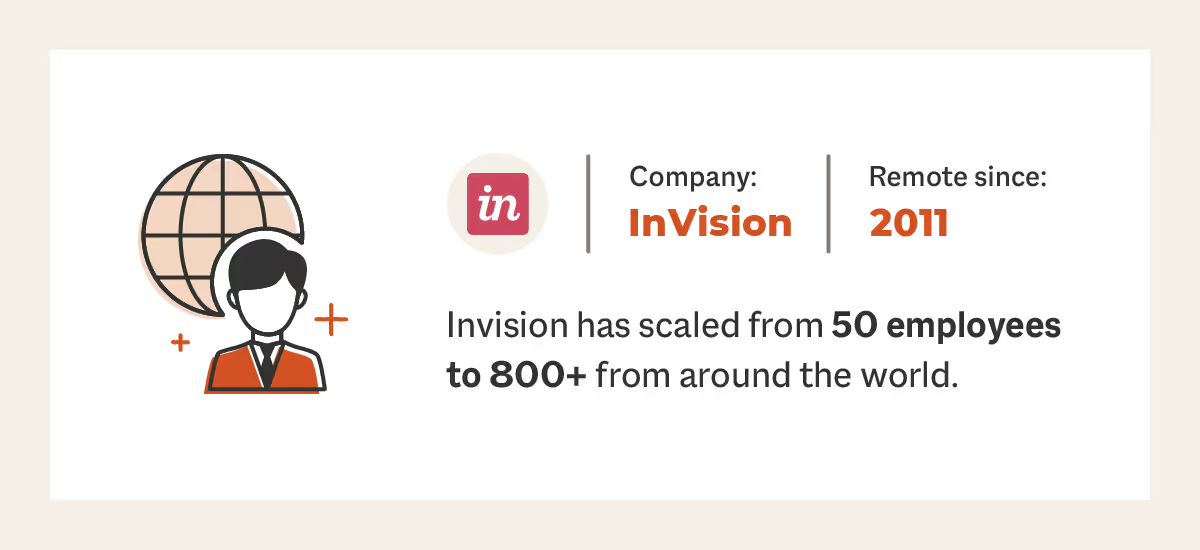
Who are they?
InVision is a prototyping tool created for designers that allows you to quickly and easily create interactive mockups for your designs for effective and easy sharing. InVision has been a fully remote company since its founding in 2011.
Company’s success:
Invision has grown exponentially as a company, scaling from 50 employees to 800+ in just three and a half years.
How they do it:
Since InVision is fully remote, they have the ability to hire anyone no matter where they are from in the world. This allows their employees to work from all corners of the world, including England, Australia, Argentina, and Nigeria. This enables InVision to find talent world-wide, creating a larger and more diverse workforce.
While a growing workforce tends to make culture dwindle, InVision’s CEO and senior staff prioritize employee happiness, which has remained solid even during rapid growth periods.
That's a wrap!
Check out the full infographic below:
.avif)
While there are many benefits to a virtual workplace, one of the most profound evidence to a successful switch is employee satisfaction, as it boosts productivity and overall well-being.
You don't have to have a physical location or on-site employees for a successful business (take it from us, as Smith.ai has operated remotely from the start, back in 2015!). If you are planning on making the switch, consider hiring our 24/7 virtual receptionists who cover everything from friendly 24/7 phone answering to lead screening to appointment scheduling, helping ease the load for you and your employees as you transition to new workplace arrangements better suited to our increasingly remote-first world. To learn more about ways Smith.ai can support your business (whether you operate virtually or not), book a free consultation!
Sources: NCCI | Washington Post | Upwork | OwlLabs | Global Workplace Analytics | Findstack | Comparably | Adobe | Harvard Business Review | FlexJobs | GitLab | InVision
Take the faster path to growth. Get Smith.ai today.
Key Areas to Explore
Technical Implementation Terms
Voice user interface (VUl) design
Speech recognition integration
Text-to-speech optimization
API connectivity and webhooks
Real-time data synchronization

Your submission has been received!












.avif)

.svg)



